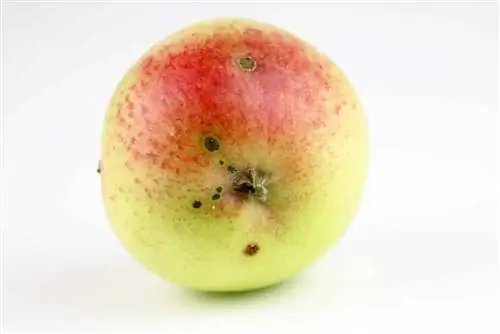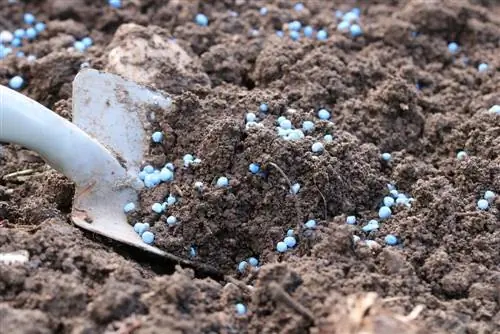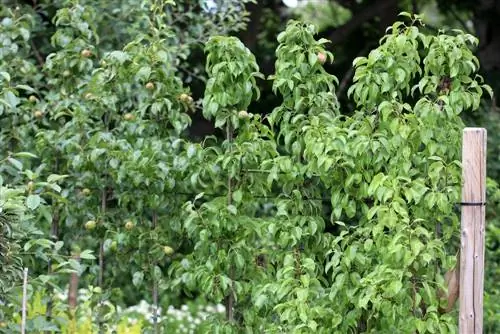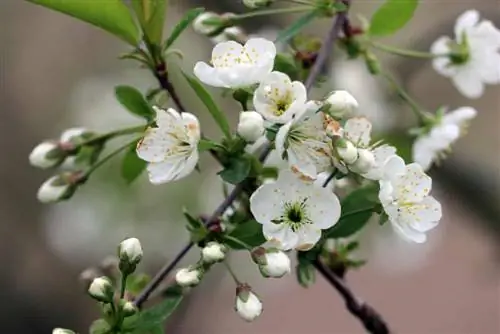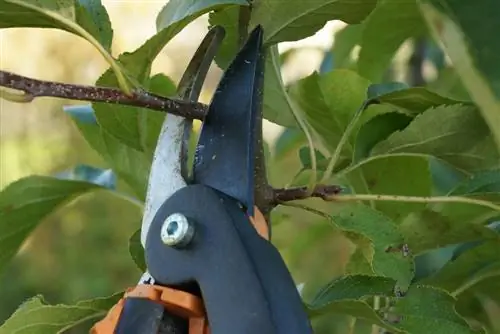- Author admin [email protected].
- Public 2023-12-17 03:39.
- Last modified 2025-01-24 12:45.
Pruning is an indispensable part of garden care because it ensures vitality and good growth of apple trees as well as a productive harvest. Although this care measure is offered by professionals, hobby gardeners can also carry out the tree pruning themselves. All that is essential here is the necessary know-how and the appropriate equipment. In this article you will learn how and when to prune your apple tree and which pruning tool is best for it.
The optimal time
As a rule, apple trees are preferably pruned in the winter months, although the exact time for this cannot be determined. When exactly the cut takes place depends on various factors: On the one hand, the growth rate of the trees plays a role, because the stronger the apple tree grows, the later it is cut. Furthermore, the weather as well as the general condition and the desired pruning technique are of course other factors that influence the timing of the tree pruning. The apple trees can be cut in winter, but also in summer or autumn.
Winter cut
The cold season, more precisely from November to March, is ideal for pruning the apple tree. At this time the buds have not yet sprouted and therefore the circulation of tree sap is low. The advantage here is that the cuts can heal faster and better. In addition, the tree has no leaves in winter, which makes it easier to identify and then correct any malformations in the tree crown. However, if the tree is cut in autumn, the following should be taken into account:
- temperatures must not fall below -5 degrees
- otherwise the wood can become brittle
- Cut slightly at an angle, especially with thick branches
- because precisely horizontal cuts promote fungi and diseases
Summer cut
In the period from March to September, no radical cuts may be made on trees due to bird protection. However, it is possible to remove certain unwanted plant parts from the tree crown. These include, for example, the water shoots, which do not bear fruit and rob the apple tree of valuable energy. Additionally, if a tree bears an enormous amount of fruit, some of them can be removed. If the apple tree is cut in summer, the following should be noted:
- do not cut during a heat wave
- also not in very dry conditions
- because the many interfaces could cause the tree to dry out
- so water thoroughly, especially after cutting
Autumn cut
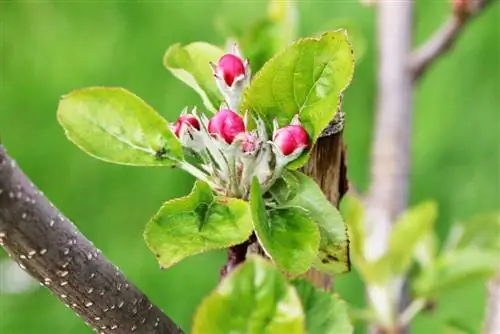
Autumn not only invites you to harvest the tasty fruits of the apple tree, but also to prun it straight afterwards. First, the underdeveloped and dead fruits are removed. The so-called fruit mummies are an ideal breeding ground for fungi and other pathogens. In autumn, the following unwanted plant parts of the apple tree can also be removed:
- dead and diseased branches
- kinked and dry shoots
- branches that are too close together
- Water Shots
The different cutting techniques
Pruning apple trees is a regular and essential care measure that takes place in the first year of planting. Cutting can directly influence various factors, such as growth and growth form. That's why there are different cutting techniques, which have different goals and effects.
The plant cut
Young apple trees particularly benefit from so-called planting pruning. This takes place immediately after planting and, on the one hand, ensures good growth and, on the other hand, it promotes the formation of a regular tree crown. The aim of the planting cut is that a strong leading shoot forms in the middle and around three to four side shoots act as leading branches, which together form the framework. Ideally, these protrude about 60 degrees from the central shoot and have outward-facing shoot tips. When cutting the plant, the following should be taken into account:
- shorten all side shoots slightly
- also shorten the middle shoot a little
- shortening these branches is also called “sap scale”
- This means they branch better and are evenly supplied with nutrients
- the framework should be pyramid-shaped
- and become narrower towards the top
- this means that all shoots get enough light
- Remove competitive instincts
- and generally remove all vertically growing shoots
Tip:
Branches growing steeply upwards can be brought into a horizontal shape by bending them down and tying them. A soft and stretchy material, such as a coconut knit, is particularly suitable for this.
The build-up cut

In the first autumn after planting, the apple tree should be subjected to the so-called development pruning, which is also called training pruning. At this point, the first annual shoots have already developed, although they are not yet bearing fruit. Because the tasty apples are only formed on the two-year-old shoots. Nevertheless, the young tree should be subjected to this pruning, because the pruning ensures good branching and also promotes the spindle-shaped growth of the tree crown. The construction cut is as follows:
- remove all side shoots growing steeply upwards
- shorten long, unbranched shoots
- remove shoots that hang too downwards
- cut off inwardly growing shoots
- Short the scaffold shoots by about a third
- this is based on new growth
- Side scaffold shoots should be shortened to the same height
- Shorten the main shoot too
Tip:
If one scaffold shoot is significantly weaker than the others, it is advisable that all shoots are shortened by half.
Conservation cut
Approximately five to seven years after planting, the apple tree's crown is established. Now it is important to maintain the fertility and vitality of the tree. This works best if the apple tree is regularly (at best annually) pruned for maintenance purposes. This care measure also has other advantages: thinning ensures a better supply of light, which means the leaves dry faster after rain and the fruits ripen better. This cut also promotes a more stable load-bearing capacity of the branches, which is particularly advantageous for many and heavy fruits. Last but not least, the work involved in harvesting is made easier because regular pruning makes the treetop much easier to access. The maintenance cut includes the following work steps:
- cut off shoots that grow steeply upwards
- Otherwise these will condense the tree crown too much
- Remove old fruit wood (usually hangs down heavily)
- because these hardly bear good quality fruit
- removing dead wood
- Cut off water shoots on the branch string
- these bear no fruit and rob the tree of strength
- Scaffolding branches are not shortened, but the tips are “slimmed”
- remove those shoots that grow too densely at the tips of the shoots
Tip:
If branches and shoots are only shortened, they are cut off just above the branching point. As a result, the crown grows wider and is therefore more permeable to air and light.
Rejuvenation cut
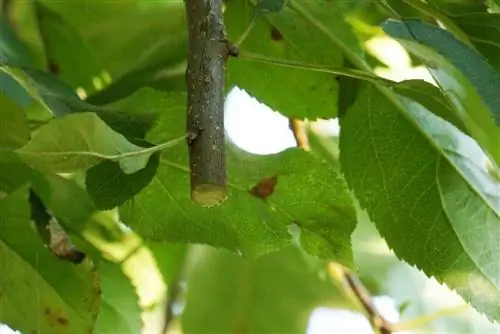
Very old or senescent trees can be brought back into shape with a rejuvenation cut. However, this is not a cut that should be carried out regularly, but rather a rescue measure. This requires particular specialist knowledge, which is why the rejuvenation cut is best carried out by experts. This cut is quite radical and it can happen that very old trees in particular lose around a third of their crown as a result. This also puts an enormous strain on the tree, which is why in some cases it is even advisable to divide the rejuvenation cut over two years. The aim of the rejuvenation cut is to stimulate the formation of new shoots and includes, among other things, the following work steps:
- Create new scaffolding
- when the old one can no longer be seen or can only barely be seen
- remove all competing shoots
- leave about four shoots
- completely remove the shoots growing steeply upwards
- Slimming the scaffold shoot tips
- remove strong fruit shoots
- redirect fruit shoots that are too long
- cut off inwardly growing shoots
- cut off shoots that grow too steeply
Tip:
After rejuvenation pruning, the tree tries to restore the balance between the crown and the roots. That's why it forms numerous young shoots at the interfaces, at least half of which should be removed every year.
The equipment
Depending on the work being done, different cutting tools are required. Basically, a sturdy ladder and sharp and clean cutting tools are necessary for tree pruning. Tree saws have proven useful for thicker branches, some of which are equipped with a cable pull or a telescopic rod. Anvil pruners or bypass pruners are suitable for thinner branches. It is often said that a wound closure agent should be used especially for cuts on thick branches. However, opinions differ here, especially since it has now been found that a wound closure agent can even have a negative impact on wound healing. If a wound closure agent is still used, the following procedure should be followed:
- Never apply it to the entire cut
- but only the edge of the wound
- before that, smooth the edge of the wound with a sharp cutting tool
Conclusion
Regular pruning of apple trees is an essential care measure that promotes both the growth and vitality of the tree. As a rule, the trees are cut in winter, although in some cases, such as after planting, cutting in autumn or summer is also conceivable.


